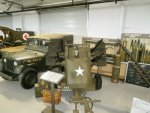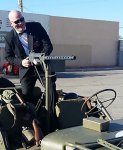acenipplelicker
Banned
About the Guns:
The .50 caliber machine guns displayed with this mount are non-operational. The two guns that are located on the gunners' left side are from a P-38 fighter aircraft that crashed in the local area during WWII. The two guns located on the gunners' right side are professionally manufactured models that were never designed to function as actual weapons. The .50 caliber ammunition used in this display is original in inert condition.
In referring back to the guns recovered from the P-38 fighter aircraft, allow me to describe historical events as I know them, relative to their recovery and restoration.
During WWII, a P-38 fighter aircraft from the Santa Maria Army Airbase was on a training flight east of Santa Maria over a mountainous undeveloped region, used mainly for cattle grazing. While executing training maneuvers, the aircraft crashed, and the pilot was killed. Due to the remote inaccessible area of the crash, no attempt was made to recover the plane. The pilot, who was killed in the crash was subsequently recovered by cowboys on horseback from a nearby ranch. The pilot was turned over to military officials.
Several years later, local residents found the crash site, noting the damaged aircraft to be more or less in tact. The guns, four .50 caliber Browning machine guns and one 20 mm cannon which were severely damaged in the crash, were subsequently removed for future restoration. Unfortunately, the 20 mm cannon was too heavy to carry by members of the recovery party, so it was left adjacent to the trail to be recovered at a later time. The cannon was never recovered.
The four machine guns were subsequently stored in an old garage with the intent that they were to be restored at some future time. As time and events passed, the guns were never restored, instead left to deteriorate.
Discovering the machine guns approximately 12 years ago, Mr. Kinney managed to acquire them in an effort to preserve their history. Notably two of the guns were restorable, the other two were damaged beyond the possibility of restoration and subsequently disposed of.
To comply with BATF regulations, the guns were completely stripped of all internal parts. A solid steel block was welded into the forward receiver area of each gun, and the right side plates were cut in two places, rendering the guns non-operational, and non-rebuild able. The guns essentially became non-guns, reconfigured for historical display purposes only.
The restoration process required that some of the damaged, original exterior parts be replaced with NOS (new original surplus) parts to maintain the original appearance of the guns. Also the metal surfaces were refinished by a process known as Parkerizing.
Hundreds of hours were devoted to this project in an effort to preserve WWII historical equipment for the benefit of all those who will visit this display.
====
Lockheed P-38 Lightning
Aircraft model
The Lockheed P-38 Lightning was a World War II American piston-engined fighter aircraft. Developed to a United States Army Air Corps requirement, the P-38 had distinctive twin booms and a central nacelle containing the cockpit and armament. Wikipedia
Top speed: 443 mph
Wingspan: 52′ 0″
Length: 38′
Cruise speed: 275 mph
Engine type: Allison V-1710
Unit cost: 97,147–97,147 USD (1944)
Manufacturer: Lockheed Corporation---------built to counter the Japanese zero which was a good aircraft.
===============================================================================================
Caliber .50 inches (12.7mm)
Muzzle Velocity 2,930 feet per second
Effective Range 2500 yards
Rate of fire 1,600 - 2200 rounds per minute
Weight Approx 2400 pounds
Height (guns level 55 inches
Height (guns fully elevated) 75 inches
Length 6' 4.5"
width 6' 9"
=======================
PICS BELOW
---


The .50 caliber machine guns displayed with this mount are non-operational. The two guns that are located on the gunners' left side are from a P-38 fighter aircraft that crashed in the local area during WWII. The two guns located on the gunners' right side are professionally manufactured models that were never designed to function as actual weapons. The .50 caliber ammunition used in this display is original in inert condition.
In referring back to the guns recovered from the P-38 fighter aircraft, allow me to describe historical events as I know them, relative to their recovery and restoration.
During WWII, a P-38 fighter aircraft from the Santa Maria Army Airbase was on a training flight east of Santa Maria over a mountainous undeveloped region, used mainly for cattle grazing. While executing training maneuvers, the aircraft crashed, and the pilot was killed. Due to the remote inaccessible area of the crash, no attempt was made to recover the plane. The pilot, who was killed in the crash was subsequently recovered by cowboys on horseback from a nearby ranch. The pilot was turned over to military officials.
Several years later, local residents found the crash site, noting the damaged aircraft to be more or less in tact. The guns, four .50 caliber Browning machine guns and one 20 mm cannon which were severely damaged in the crash, were subsequently removed for future restoration. Unfortunately, the 20 mm cannon was too heavy to carry by members of the recovery party, so it was left adjacent to the trail to be recovered at a later time. The cannon was never recovered.
The four machine guns were subsequently stored in an old garage with the intent that they were to be restored at some future time. As time and events passed, the guns were never restored, instead left to deteriorate.
Discovering the machine guns approximately 12 years ago, Mr. Kinney managed to acquire them in an effort to preserve their history. Notably two of the guns were restorable, the other two were damaged beyond the possibility of restoration and subsequently disposed of.
To comply with BATF regulations, the guns were completely stripped of all internal parts. A solid steel block was welded into the forward receiver area of each gun, and the right side plates were cut in two places, rendering the guns non-operational, and non-rebuild able. The guns essentially became non-guns, reconfigured for historical display purposes only.
The restoration process required that some of the damaged, original exterior parts be replaced with NOS (new original surplus) parts to maintain the original appearance of the guns. Also the metal surfaces were refinished by a process known as Parkerizing.
Hundreds of hours were devoted to this project in an effort to preserve WWII historical equipment for the benefit of all those who will visit this display.
====
Lockheed P-38 Lightning
Aircraft model
The Lockheed P-38 Lightning was a World War II American piston-engined fighter aircraft. Developed to a United States Army Air Corps requirement, the P-38 had distinctive twin booms and a central nacelle containing the cockpit and armament. Wikipedia
Top speed: 443 mph
Wingspan: 52′ 0″
Length: 38′
Cruise speed: 275 mph
Engine type: Allison V-1710
Unit cost: 97,147–97,147 USD (1944)
Manufacturer: Lockheed Corporation---------built to counter the Japanese zero which was a good aircraft.
===============================================================================================
Caliber .50 inches (12.7mm)
Muzzle Velocity 2,930 feet per second
Effective Range 2500 yards
Rate of fire 1,600 - 2200 rounds per minute
Weight Approx 2400 pounds
Height (guns level 55 inches
Height (guns fully elevated) 75 inches
Length 6' 4.5"
width 6' 9"
=======================
PICS BELOW
---



